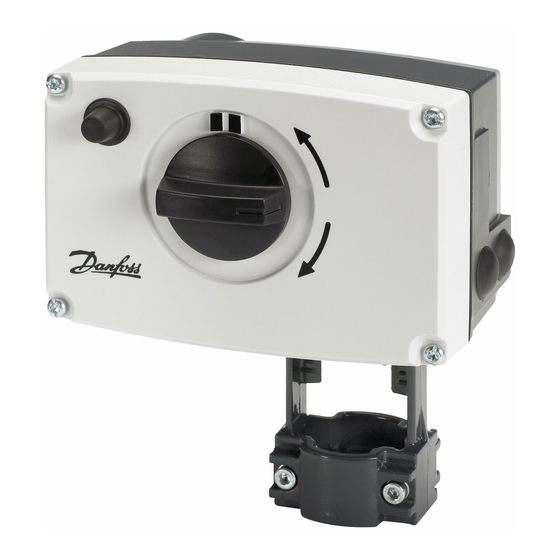Danfoss AME 25 SU Instrukcja obsługi - Strona 6
Przeglądaj online lub pobierz pdf Instrukcja obsługi dla Napędy DC Danfoss AME 25 SU. Danfoss AME 25 SU 16 stron.

AME 25 SU, AME 25 SD
ENGLISH
Safety Note
To avoid injury of persons and
damages to the device, it is absolutely
necessary to read and observe these
instructions carefully.
Necessary assembly, start-up, and maintenance
work must be performed by qualified and
authorized personnel only.
Please comply with the instructions of the
system manufacturer or system operator.
Do not remove the cover before the
power supply is fully switched off.
Disposal instruction
This product should be dismantled
and its components sorted, if possible,
in various groups before recycling or
disposal.
Always follow the local disposal regulations.
Mounting
Fix the actuator on the valve. ❶
Admissible Installation Positions. ❷
Wiring
❸
Do not touch anything on the PCB!
Switch off the power line before wire
the actuator! Lethal voltage!
Wire the actuator according to the wiring
diagram.
Control signal
Control signal from the controller must be
connected to terminals Y (input signal) and SN
(common) on the AME printed board.
Output signal
Output signal from the terminal X can be used
for indication of the current position. Range
depends on the DIP switch settings.
Supply voltage
Supply voltage
(24 V~ –15 to +10 %, 50/60 Hz) must be
connected to the terminals SN and SP.
DIP switch settings
❹
U
I
2 V_---V
0 V_---V
Direct
Inverse
---
Sequential
0(2) V_5(6) V
5(6) V_10 V
Proportional
3 point/RL
LOG. flow
LIN. flow
100 % k
RED. k
VS
Reset
Reset
Part Name
Lead (Pb)
Bush
X
Electromagnet
X
Housings
X
Brake Weights
X
Clamp
X
Yoke
X
6 | © Danfoss | 2016.12
Factory settings:
ALL switches are on OFF position! ❹①
Note: All combinations of DIP switches are
allowed. All functions that are selected are
added consecutively. There is only one logic
override of functionalities i.e. the switch No.6
Proportional/3 point, which sets actuator to
ignore control signal and works as a "simple"
3-point actuator.
SW1: U/I ❹②
Factory setting:
voltage control signal (0-10 V).
SW2: 2-10 V/0-10 V ❹③
Factory setting is:
2-10 V.
SW3: Direct/Inverse ❹④
Factory setting is:
DIRECT
SW4:---/Sequential ❹⑤
Two actuators can be set to work parallel with
one control signal. If the SEQUENTIAL is set then
an actuator responds to split control signal (see
0(2)-5(6) V/5(6)-10 V).
Note: This combination works in combination
with switch No. 5: 0(2)-5(6) V/5(6)-10 V
SW5: 0(2)-5(6) V/5(6)-10 V ❹⑥
Note: This function is available if switch No. 4:
--- / Sequential is set.
SW6: Proportional/3 point ❹⑦
Actuator can operate as "simple" 3-point
actuator, if the 3-point function is selected.
Power supply should be connected on SN
and SP ports. On port 1 or 3 24 VAC signal is
connected for rising or lowering of actuator.
Return signal X indicates the correct position.
Note: if 3 point function is selected actuator
does not respond to any control signal on
port Y. It only rises and lowers spindle if power
is supplied on port 1 or 3.
SW6: Proportional/3 point ❹⑦
Actuator can operate in modulating (DIP 6 to
OFF) or in "simple" 3-point mode, if the 3-point
function is selected (DIP 6 to ON).
VS
Connect power supply on terminals SN and SP
terminals.
Mercury (Hg)
Cadmium (Cd)
Hexavalent Chromium (Cr(VI))
O
O
O
O
O
O
O
O
O
O
O
O
Actuator needs to perform Self
stroking prior changing DIP 6 to ON.
Output signal depends on DIP 2, 3&5
setting.
Hazardous Substances Table
Polybrominated biphenyls (PBB)
O
O
O
O
O
O
Factory set DIP 6 to OFF for operating actuator
in Modulating mode.
Actuator's stem will run to its totally extended
or retracted position by bridging SN signal to
terminals 1 or 3 and will remain in this positron
as long as potential is present.
Set DIP 6 to ON for operating actuator in 3 point
mode.
Look carefully wiring diagram as wiring is
different for controllers with triac output (ECL)
in comparison to controllers with relay output.
Return signal X indicates the correct position.
Note: If 3 point function is selected actuator
does not respond to any control signal on
port Y. It only rises and lowers spindle if power
is supplied on port 1 or 3.
SW8: 100% K
/RED. K
❹⑨
VS
VS
Note: This function works proper only with
logarithmic (equal percentage) valves.
SW9: Reset ❹⑩
After the actuator has been connected to
power supply, the actuator will start the
self-adjustment procedure. The indicator LED
flashes until self adjustment is finished. The
duration depends on the spindle travel and will
normally last a few minutes. The stroke length
of the valve is stored in the memory after self
adjustment has been completed. To restart
self adjustment, change the position of RESET
switch (switch No. 9). If the supply voltage is
switched off or falls below 80 % in more then
0.1 s, the current valve position will be stored
in the memory and all data remain saved in the
memory also after a power supply cut-out.
Function test
The indicator light shows whether the
positioner is in operation or not. Moreover, the
indicator shows the control status and faults.
Constant light
- normal operation
No light
- no operation or no power supply
Intermittent light (1 Hz)
- self adjusting-mode
Intermittent light (3 Hz):
- power supply too low
- insufficient valve stroke (<20 s)
- end-position cannot be reached.
Dimensions
❺
Polybrominated diphenyl ethers (PBDE)
O
O
O
O
O
O
O
O
O
O
O
O
VI.AD.B3.8C
